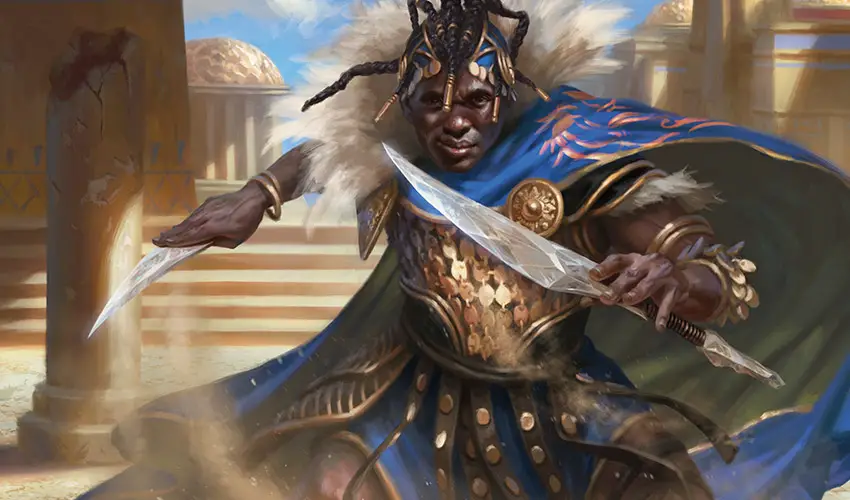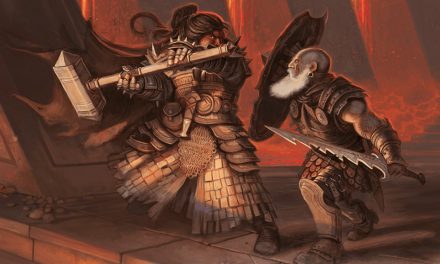So, you’ve encountered a problem: you want to make introductions between an enemy and the business end of your spear, but you’re just not close enough.
That’s when the idea hits you: why not just throw the spear at your enemy?
It’s easy to get confused with how thrown weapons work in D&D 5e. However, once you learn the ins and outs, you’ll be able to yeet daggers, spears, and whatever else you want to your heart’s content!
So today we’re taking aim and clearing up the confusion on this fun and stylish mechanic.
This article will cover everything you need to know about using throwing weapons in D&D 5e!
The Thrown Weapon Property
Let’s take it from the very top!
In theory, you can throw anything that you’re strong enough to handle. But that’s not really what we’re talking about when we mention throwing weapons.
We’re specifically talking about weapons that have the “Thrown” property.
While we’ll go over your weapon options in more detail in a bit, suffice it to say that this includes things like daggers, spears, darts, handaxes, and nets.
In other words, things that tend to be aerodynamic enough to justify relying on as a thrown weapon in combat.
That means that weapons without the “Thrown” property (like battleaxes or scimitars) are excluded from this.
Any weapon with the Thrown property can be used to make a ranged attack using the same modifier used to make a melee attack and damage roll with that weapon.
Thrown weapons tend to be effective over shorter distances compared to ranged-only weapons like bows or slings.
So, for example, a spear can be used in melee combat or thrown (at a range of 20 feet or 60 feet for long-range). While this doesn’t come near the range of a shortbow (which is 80 feet or 320 long-range), you do get the benefit of versatility from the spear.
Related: Ranged Combat in D&D 5e Explained

How Thrown Weapons Work in D&D 5e
When making a ranged attack with a thrown weapon, you use your Strength or Dexterity modifier to determine the attack bonus, depending on the weapon and your preference.
For example, if you are using a dagger, you could use your Strength modifier for the attack roll, or (because daggers also have the Finesse property) your Dexterity modifier if you prefer.
The range of a thrown weapon is typically shorter than a ranged-only weapon, but it varies depending on the specific weapon.
For example, a dagger has a range of 20/60 which means that you can make a ranged attack with it up to 20 feet away without disadvantage, but beyond that, you have disadvantage on the attack roll. If you attempt to make an attack beyond the weapon’s maximum range, the attack automatically misses.
Calculating your thrown weapon’s damage works similarly.
When making a ranged attack with a thrown weapon, you deal damage just as you would with a melee attack. Simply use the weapon’s damage die and add your Strength (or Dexterity modifier if it’s a Finesse weapon) to the damage roll.
For example, if you are using a javelin and have a Strength modifier of +2, you would roll a d6 for damage and add 2 to the result.
It’s important to note that when you make a ranged attack with a thrown weapon, you are still considered to be making a weapon attack, not a ranged attack.
This means that any features or abilities that affect weapon attacks will also apply to thrown weapon attacks. Similarly, features and abilities that affect ranged attacks (like the Archery fighting style) do not apply to thrown weapon attacks.
Strength-Based Throwing Weapons
Every weapon that can be thrown can use your Strength modifier for the attack and damage roll. However, there are some that we’ll cover in the next section which can alternatively use your Dexterity.
But let’s focus on Strength for now.
Thrown weapons that only use Strength in the Player’s Handbook are: handaxes, javelins, light hammers, spears, tridents, and nets.
With the exception of javelins and nets, these all have a range of 20/60.
Javelins have a better range of 30/120, which makes them particularly ideal if you need the extra distance. Nets have a less impressive range of 5/15 but are able to potentially restrain targets.
Additionally, each of these weapons deals 1d6 damage except for light hammers (which deal 1d4) and nets (which are something else entirely).
Nets get a little tricky, so we’ll cover them in more detail shortly.

Dexterity-Based Throwing Weapons
In the Player’s Handbook, there are two thrown weapons that also have the Finesse property. That means that these can use either your Dexterity or Strength modifiers.
If you’re going for a Dexterity build but still want to use throwing weapons, look no further than daggers and darts!
Both daggers and darts have a thrown range of 20/60 and deal 1d4 piercing damage.
For Rogues, Dexterity-based Fighters and Rangers, many Bards, and even certain Monks, this is a common option.
In fact, one of my players had a blast playing as a Way of Shadow Monk who greatly favored throwing weapons. We reskinned the daggers as kunai to better fit his character’s ninja theme and they were his go-to Monk Weapon throughout the adventure!
And speaking of Monks…
Monks do have the seriously cool ability to catch enemy projectiles and throw them back.
While this does fit much of what we’re discussing in this article, I’d recommend checking out my guide to the Monk’s Deflect Missiles feature for more information on how that works.
Throwing Nets
The humble net might just be the most underrated and misunderstood weapon in all of D&D 5e.
As I mentioned earlier, the rules for throwing weapons still apply to using a net. However, it serves a different role than your typical javelin or throwing dagger.
You’ll notice that the standard net doesn’t deal any damage and has a modest throwing range of 5 feet (and as much as 15 feet with disadvantage.)
The kicker for the net is that an enemy that you hit with it is restrained.
This means that:
- The creature has a speed of 0 and doesn’t benefit from any speed bonuses.
- Gets disadvantage on its attack rolls and Dexterity saving throws.
- Attacks against the creature are made with advantage.
So, by catching an enemy in a net, you and your allies are able to absolutely punish them. The longer it takes them to break free, the more punishment they’re going to have to endure!
Now, this obviously won’t work on enemies that are formless/incorporeal (like slimes or specters) or Huge enemies (like Frost Giants or the Tarrasque).
But for your standard encounters, a well-placed net can be almost insultingly effective!

Throwing Improvised Weapons
So, what about situations where you’re throwing things that are either weapons without the “Thrown” property or aren’t necessarily “proper” weapons at all?
In this case, we’re talking about throwing improvised weapons.
You might be throwing a longsword, a bottle, a hefty wheel of cheese, or maybe even a dead goblin.
In these situations, the improvised weapon being thrown has a range of 20/60 and deals 1d4 damage. The type of damage is up to the Dungeon Master based on whatever makes the most sense.
The vast majority of these improvised weapons are going to be thrown using your Strength modifier for the attack roll and damage. After all, “finesse” isn’t exactly the word that comes to mind when you watch a Barbarian wreck somebody with a wagon wheel from 20 feet away…
However, an argument might exist to be made with certain lighter objects like a bottle or something. I could see it making sense that those could work with Dexterity as well.
Still, that’s entirely up to your DM’s discretion.
What Classes Benefit from Thrown Weapons in D&D 5e?
Using throwing weapons really fits more into how you want your character to play rather than strictly what class you’re playing as. However, there are some that generally stand to benefit more.
Barbarians immediately come to mind. While they can have a field day when they’re able to get up close to enemies, they tend to have a harder time dealing with enemies at range.
It’s not a bad idea for a Barbarian to keep a few javelins handy for those occasions when they’re dealing with a flying or otherwise elusive enemy.
Of course, there’s also the Path of the Giant Barbarian who specializes in throwing weapons to devastating effect!
Fighters, Paladins, and Rangers stand to gain a lot from throwing weapons as well.
If they focus on Dexterity, they’ll likely have a bow or crossbow ready for most encounters. But focusing on Strength doesn’t have to mean that they’re useless at range!
As I mentioned earlier in the article, some of the “quicker” classes (like Rogues, Monks, and Bards) can potentially make good use of thrown finesse weapons.
Imagine an Assassin Rogue who uses their throwing daggers or darts to deliver a deadly poison to their enemies.
Similarly, perhaps a College of Whispers Bard who uses their throwing knives to activate their Psychic Blades feature!
All in all, full-casters (like Clerics, Druids, Sorcerers, Wizards, and Warlocks) will generally have the least use for thrown weapons. After all, there’s little reason to throw an axe when you could just as easily launch a fire bolt or an eldritch blast at the enemy.

Thrown Weapons Fighting Style
One of the many new options introduced in Tasha’s Cauldron of Everything is the Thrown Weapon Fighting Style.
This fighting style is available to Fighters and Rangers and, as the name implies, makes you better at fighting with thrown weapons.
Specifically, you’re able to draw weapons that have the “Thrown” property as part of the attack that you make with that weapon.
This makes for a much more seamless use of your action economy when fighting with thrown weapons. Additionally, you get to add an extra 2 damage to attacks that hit with thrown weapons!
If you want to specialize in throwing weapons, it might very well be worth taking a level in Fighter (or two levels in Ranger) to grab this Fighting Style.
You can learn how that works in my full guide to multiclassing in D&D 5e!
Thrown Weapons and Two-Weapon Fighting
You absolutely can combine throwing weapons and two-weapon fighting in D&D 5e. However, there are several factors that you need to be mindful of.
Remember the first rule that we covered: weapons need to specifically have the “Thrown” property for this to work.
Unless you take the Dual Wielder feat, you’ll need to also make sure that the weapons you are using also have the “Light” property.
This leaves you with the options of daggers, handaxes, and light hammers.
If you do take the dual-wielder feat, you’re able to use two-weapon fighting even when the one-handed melee weapons you are wielding aren’t light.
This opens up the somewhat funny mental image of dual-yeeting spears, javelins, tridents, or even nets.
Though you’d most likely be looking at a combination of the two.
Perhaps you throw the net with one hand and then follow up with a spear thrust (at advantage versus a restrained target!) using the other hand.
There’s really no shortage of ways to mix and match. Just make sure that you are satisfying the requirements of both dual-wielding AND throwing weapons!
But juggling should come naturally to you at this point, right?
(Note: There is a slight “chicken and the egg” issue with how these two mix when it comes to drawing weapons and attacking. Personally, if a player is taking a feat, I’m not one to micromanage the details. Let them do cool stuff.)
If you’re looking at mixing throwing weapons and dual-wielding, I recommend checking out my guide to two-weapon fighting in D&D 5e!

The Hazards of Thrown Weapons in D&D 5e
There are two major risks that you have to stay aware of if you’re focusing on using throwing weapons in D&D 5e.
The first is the simple fact that your fighting style also relies on disarming yourself.
If you find yourself with no more daggers left to throw, you could potentially end up in a very bad situation of being left unarmed if you’re not careful!
So, let’s say that you’re carrying 18 daggers and throwing two of them per round. The odds of a combat going for a whopping 9 rounds are pretty slim. However, it certainly does happen!
Furthermore, you will need to make sure that you and your party can make time for you to gather your knives before progressing forward. In high-stakes situations where time is of the essence, this can be a nasty complication!
But this ties into the second problem that you need to be aware of with throwing weapons…
If you’re lugging a sack full of javelins, axes, daggers, and spears everywhere, you’re going to get encumbered very quickly.
Now, I’ve seen very few tables that actively use encumbrance rules in all but the most extreme situations. Most of the time, you can acquire a bag of holding and, more or less, call it a day.
However, that doesn’t remove the need to have a plan for the logistics of how you’re carrying and using your equipment.
Daggers are easy enough to keep on your person and draw as you need them. Walking around with 40 pounds of javelins on your back is a bit of a different story though…
Have a plan!

Thrown Weapons 5e – FAQs
Before we wrap up, I want to address some frequently asked questions about Throwing Weapons in D&D 5e.
As always, let me know in the comments if you still have questions. I’m always happy to help!
What About Acid Flasks, Alchemist’s Fire, Holy Water, etc?
Funny enough, items like Acid Flasks, Oil, Holy Water, and Alchemist’s Fire don’t actually count as thrown weapons.
Using their descriptions in the PHB, they actually count as ranged attacks instead of a Thrown Weapon.
In the case of items like this, it’s treated as an improvised weapon but uses a ranged attack which means you would calculate it as d20 + Dex + any applicable bonuses.
The goal of these items is less about bonking an enemy on the head with a glass jar and more about having that jar burst and (ideally) spill its contents over multiple enemies or, otherwise, a large area.
To my understanding, the distinction of these items as improvised weapons is more about not applying your proficiency bonus to throwing them.
If you just simply MUST have that proficiency bonus, consider grabbing the Tavern Brawler feat. Though I wouldn’t really worry about it, to be honest.
The goal is certainly to splash the contents over a certain area. However, you might be able to try to land a direct hit on an enemy to deal that extra 1d4 + DEX damage.
Though that might presumably come at the risk of entirely missing and your AoE from the acid/fire/water/oil/etc being far away from where it would be most helpful…
Do Thrown Weapons Benefit from the Sharpshooter Feat?
Oh boy… this is one of those questions that has had no shortage of debates about it…
Personally, I’m going with what rules-boss Jeremy Crawford had to say on Twitter on the matter. Of course, as always, talk about this with your DM to find what works best for your table.
As Crawford explains, the distinction here is between a ranged weapon and a ranged weapon attack.
So, a thrown weapon (let’s say a dagger), WOULD gain the first two benefits of the Sharpshooter feat. Specifically, attacks at long range are not made with disadvantage AND ranged attacks ignore half and three-quarters cover.
However, because thrown weapons like daggers are not ranged weapons (like a bow or crossbow), they don’t qualify for the third benefit of the Sharpshooter feat.
Specifically, you cannot take a -5 to your attack with a thrown weapon to potentially deal an extra 10 damage. That is reserved for ranged weapons.
Interestingly, as a weapon that has the “Thrown” property AND is a ranged weapon, the humble dart would be an exception to this as it satisfies all of these criteria.
Can You Throw a Weapon That Doesn’t Have the Thrown Property?
Yes. These would be considered to be improvised thrown weapons as described above.
The item would have a range of 20/60 and deals 1d4 damage.

Can Paladins Smite with a Thrown Weapon?
No. Paladins’ Divine Smite feature can only be triggered upon hitting a creature with a melee weapon attack.
They are not able to use their Divine Smite feature at range, whether with a thrown weapon or a ranged weapon (like a bow).
Do Barbarians Add Rage Damage to Thrown Weapons?
No. The bonus damage that Barbarians add to their attacks is only added to melee weapon attacks that use their Strength.
Because a thrown weapon is not a melee weapon attack, the bonus damage from their Rage feature does not apply.
The exception to this is the Path of the Giant Barbarian who gains a unique feature that allows them to add this damage to their thrown weapon attacks.
Related: Barbarian Rage in D&D 5e Explained!
Does Thrown Weapon Fighting Stack with Dueling?
Another bit that gets sticky is how the Thrown Weapon fighting style interacts with the Dueling fighting style.
For the Dueling style, you get a +2 bonus to damage rolls with a weapon if you are wielding that weapon in one hand and are not wielding any other weapons.
So, this gets into another “chicken and the egg” situation that depends on your interpretation of “wielding” a weapon.
On one hand, you were wielding the weapon and then threw it at the enemy. As such, it should stack, right?
On the other hand, by throwing the weapon, you are no longer wielding it.
Once again, let’s turn to Jeremy Crawford’s ruling on the matter. With a one-word answer of “yes”, he says that the bonus from the Dueling fighting style DOES apply to thrown weapons.
If only for the sake of letting players do cool stuff, I’m happy to agree with him.
Does Great Weapon Fighting Work with Thrown Weapons?
The Great Weapon Fighting style allows you to reroll damage dice of 1 and 2 when you’re attacking with a melee weapon that you are wielding with two hands. The weapon must have the “two-handed” or “versatile” property to gain the benefit.
The limitation of Great Weapon Fighting is to melee weapons and not strictly melee attacks. Something like a spear or trident would satisfy the requirements.
Much like before, there really isn’t a clear solution to this and the question of “what is wielding, actually?” comes back into play. So, it largely comes down to your own DM’s ruling.
For my two cents, I’d be fine with allowing Great Weapon Fighting to work with throwing weapons that satisfy the requirements of both GWF and of throwing weapons.
However, I would reason that the damage is based on the one-handed damage and not the versatile damage.
But that’s just me. I’d be genuinely interested to read other opinions on the matter in the comments!
Conclusion – Thrown Weapons in D&D 5e
Whew…
Okay, this topic ended up having WAY more to it than I expected when I started writing it. But anyhow, I hope you’ve found this guide to using thrown weapons in D&D 5e helpful!
For most of 5e’s existence, throwing weapons has generally been something that’s more of an “emergency” tactic rather than a character playstyle.
Thankfully, it’s been greatly improved with the addition of new options like the Thrown Weapon Fighting Style from TCoE.
What do you think? Will you be using thrown weapons more in your games?
Let’s chat in the comments!
Want all the latest player guides, DM tips, news, reviews, and more for D&D 5e? Sign up for the Tabletop Joab newsletter below!
You can also follow me on Facebook and Twitter!
If you found this article helpful and want to support the site, you can buy me a coffee here! (It’s not expected, but very appreciated!)









